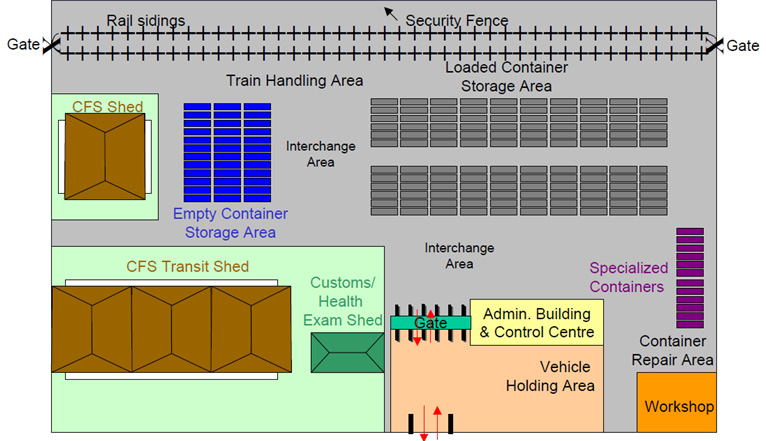About the concept
Ever since its appearance, the "dryport" concept has been associated with numerous definitions and equivalent expressions. Therefore, in the specialised literature we will find it under various names: "inland clearance depot", "inland container terminal", "dry port", "freight logistic hub".The definition of the concept also implies investigating the previous names used to refer to dryports because they appear under different names in different corners of the world: Gueterverkehrszentren in Germany, Plateformes Multimodales Logistiques in France, Freight villages in Great Britain or Interporti in Italia, Inland Port Ón SUA, Inland Container Depots in India and Asia, Estacao Aduaneira do Interior in South America, and, particularly in Brasil meaning Interior Customs Station. They all assure the container transfer from one means of transportation to another as well as auxiliary services as for example warehouses, customs services, maintenance services, ensurance offices.
In other words, dryports - DPs, a term we are going to use from here on are specific locations where containerised freight, be it for import, export or transit, can be submitted to customs inspection in order for their origin and destination to be specified. As the above definitions show, dryports are placed outside maritime ports, being connected to the import sources and export destinations. Dryports can be used irrespective of whether a country has maritime ports or not, inland transportation means representing the only access to them.

The most recent definition for dryports we have identified is the one offered by Roso in 2008: "a DP is an inland intermodal terminal directly connected to a maritime port by great capacity transportation means, where customers can leave/take their goods in a similar manner to a maritime port" (Roso, 2009), a only one classification according to distance: close, intermediary, and far away from the maritime port it is connected to. We consider it insufficiently defined for we may understand that reference is made to a construction materials warehouse which distributes China produced goods through any port in Europe with the purpose of selling it with a profit. Moreover, any Danube port with access to inland waterways may be easily described by the above definition.
It is therefore our research purpose to clarify and deepen classifications according to various criteria: the number of railways which serve DPs, their length, the access to roads, the capacity to handle containerised goods, automation, services like customs clearance, container maintenance, which all add value to container transportation.
This classification (Roso, 2009) is based only on the distance between maritime ports that dryports serve and dryports themeselves.
Our classification criteria are:
(a) according to size - handling capacity, the number of TEU per year: small, medium-size, big and mega dry ports which can be implemented in countries which do not have sea access;
(b) according to the means of access, i.e. to how many railways and roads they have for handling, entrance and exit from the dryport;
(c) according to the value added services they offer: for example, in the case of loading and unloading container freight, we may refer to welding, painting, disinfection, handling and storage of refrigerated or dangerous goods.
We may conclude that dryports, as their name suggests, must be regarded differently from the inland intermodal terminals which offer some extra advantages as compared to dryports, as for example at least one river access which means that all goods can be transferred by this means: with the support of barges, towboats or other navigation equipment; moreover, their handling equipment is a lot bigger compared to those of a dryport, close to the dimensions of a maritime terminal.
This page represents the practical component of the PhD thesis entitled "Research regarding implementation of dryport in Romania",
within the Doctoral School of Economics, Faculty of Economics and Business Administration, Alexandru Ioan Cuza University of
Iasi, Romania.


